East Trinity remediation case study
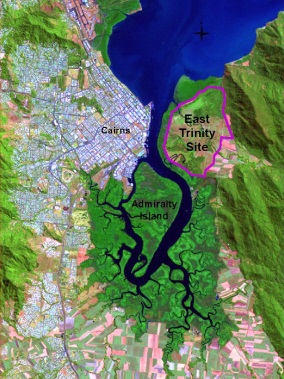
Acid sulfate soils can have environmental, health and economic effects due to the production of sulfuric acid and heavy metals.
East Trinity is a 774 hectare environmental reserve, located directly across Trinity Inlet from the Cairns central business district.
This site is one of the world’s most successful large-scale acid sulfate soil remediation projects, using technologies developed by Queensland scientists and managed in conjunction with Queensland Parks and Wildlife Service rangers.
From a healthy environment to an acid wasteland
The East Trinity site was originally a natural estuarine floodplain, covered by mangroves and salt-marsh. It was a nursery for many aquatic species and was home to many local and migratory seabirds.
In the 1970s the area was drained and levelled in order to grow sugarcane and a large 7km earth bund wall was constructed around the site. Floodgates were installed, where the bund wall crossed major streams, to prevent the natural flow of the tide over East Trinity.
In addition to excluding the tide, drains were built to also lower the water table. This meant that soils that were usually waterlogged were exposed to air. The pyrite (iron sulfide) in these soils underwent a chemical reaction which released sulfuric acid.
In years following the bund wall construction, approximately 3,000 tonnes of sulfuric acid leaked from the soil into Trinity Inlet every year along with large quantities of iron, aluminium and other metals. This resulted in many fish kills and the death of the mangrove forests.
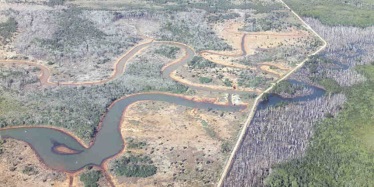
Sugarcane production failed at East Trinity and the soils and waters became highly degraded. Areas of the site recorded pH readings of as low as 2.5 (like battery acid).
In 2000 the Queensland Government purchased the property and funded a remediation program to protect Trinity Inlet and the Great Barrier Reef.
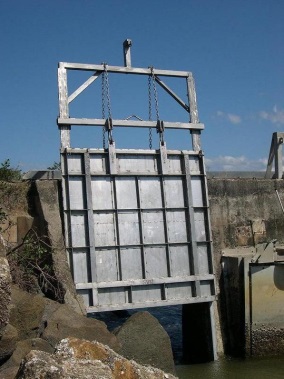
The strategy to fix East Trinity—a world first
The remediation of East Trinity is unique in its scale.
The most common treatment of acid sulfate soils is to mix an alkaline material into the soil (e.g. powdered calcium carbonate, known as agricultural lime), where it can react with the acidity and neutralise it.
In 2000, it was estimated that it would cost approximately $78 million in lime alone to treat East Trinity this way. This equated to 21,000 truckloads of lime to be taken on to the site. The method would have also been very destructive, as the earthworks to mix the lime into the soil would have required the entire site to be cleared and dug up. Even if this money was invested in the property it still did not guarantee a successful remediation.
Instead, government scientists proposed a low-cost strategy, called lime-assisted tidal exchange. This form of treatment involved reintroducing the tide to the site, by re-engineering the floodgates that had originally been used to stop the tide from entering. The aim was to stop the soils from drying further and continuing to produce acid. Seawater contains dissolved carbonate and bicarbonate and has the ability to neutralise acid. Hydrated lime (also known as slaked lime, or calcium hydroxide) was added to the tidal waters to help neutralise the acidity.
The process of lime-assisted tidal exchange
The tide is allowed onto the East Trinity site through 2 main sets of floodgates in the bund wall. As water flows in and onto the site, the height that the water reaches inside the bund wall is controlled by these floodgates. The seawater is then mixed with hydrated lime to increase the amount of alkalinity available to neutralise the soils when the water flows into the creeks and onto the land.
When the tide retreats and water leaves the site through the floodgates its quality is monitored to check that it is not acidic (i.e. pH is less than 6) and will not damage marine life in the inlet.
Groundbreaking research
The success of the remediation work at East Trinity has generated national and international research programs and led to it becoming a national demonstration site for innovative acid sulfate soil management.
The experience and research developed at East Trinity should allow other acid sulfate soils hotspots to be restored to functional estuarine habitats.
A strategy based on sound information
A large body of information and research is used to guide the remediation at East Trinity, including:
- a soil survey of the site, which used deep drilling to identify the extent of the acidic soils
- digital elevation model and flood model, which is used to predict the areas that are flooded with tidal waters
- soil profiles and samples, which have been collected and analysed at intervals throughout the remediation to assess the decrease in soil acidity
- water quality information, which is recorded every 10 minutes across key areas of the site
- vegetation and aquatic species surveys that have been conducted to assess the impact of the remediation.
Evidence of a successful remediation
In areas of the site that tidal waters had regularly reached over several years, the lime-assisted tidal exchange has been very effective. It has raised the pH of water leaving the site to above 6. Many areas of the site no longer need the daily lime addition to the tidal water as the seawater alone contains enough capacity to manage the small amount of acid generated from the site.
When the mangrove forests first died, acid tolerant paperbark trees (Melaleucas) took over large areas. These invading Melaleucas are now being recolonised by the original mangroves—a sign of a successful remediation as the site transitions back towards its natural state.
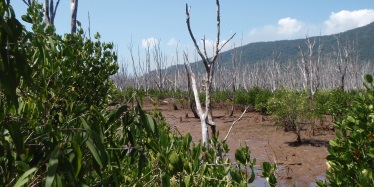
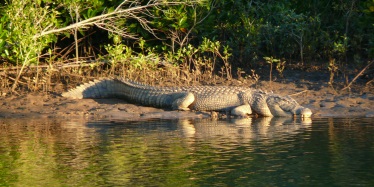
Animals, including fish and crustaceans have returned to the waterways. Crocodiles and more than 125 species of birds have begun to return to the site. The site is returning to its former state as a functioning estuarine habitat and nursery for a range of aquatic species, which are crucial for the maintenance of commercial and recreational fishing.
More information
For more information about this research, please email soils@qld.gov.au.
- East Trinity acid sulfate soils data
- East Trinity scientific and technical reports
- Saving acid wetlands (story on Catalyst TV show)
- East Trinity Reserve’s nature, culture and history
- Mandingalbay Yidinji Indigenous Protected Area


